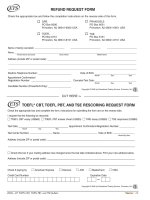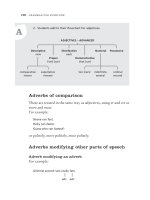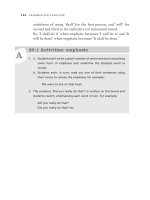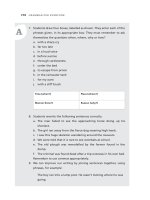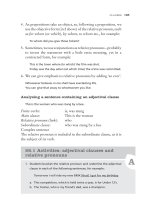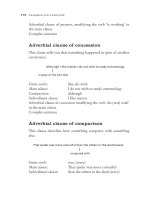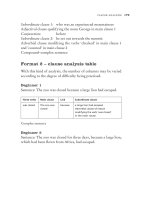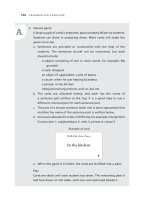Tài liệu Grammar for everyone part 32 ppt
Bạn đang xem bản rút gọn của tài liệu. Xem và tải ngay bản đầy đủ của tài liệu tại đây (313.73 KB, 7 trang )
result: of a phrase or clause, indicating something occurring due to the
action of a verb in another clause
semi-colon:
a punctuation mark used instead of a conjunction to provide
a pause, and to link two closely related parts of a sentence
sentence:
a group of words including a finite verb and expressing a
complete idea; it begins with a capital letter and ends with a full
stop, question mark or exclamation mark
simple:
of a sentence, consisting only of one main clause; of tense, of
which the action is not continuous
singular:
of nouns or pronouns, indicating single number, i.e. one only
strong:
of verbs, irregular – the inside vowel changes in the past tense
subject:
the person or thing that performs or suffers the action of the
verb; necessary to form a finite verb
subjunctive:
of mood, the verb form that expresses doubt, wish or
supposition
subordinate:
of a clause, adjectival, adverbial or noun, that is dependent
on the main clause and cannot stand alone
suffix:
word element added to the end of a base word to indicate part of
speech
tense:
of a verb, the form which shows the time at which the action of
the verb takes place
time:
of a phrase or clause, indicating something which occurs at the time
at which the action of the verb in the main clause takes place
transitive:
of a verb, one which has an object
verb:
part of speech expressing doing, being or having
vocative:
of case, a word such as a name, addressing someone
voice:
of a verb, indicating active or passive
weak:
of a verb, the past tense of which ends with ‘d’, ‘t’ or ‘ed’ in a
regular form
207
G l o s s A rY
208
Index
A
abbreviations 82, 96
abstract noun 27
accusative case 150–2
active voice 113–5, 123–4
adjectival clauses 164–6
adjectival phrases 154
adjectives 53–61, 119, 128–30
comparison 58–9
from participles 118–9
numeral 128
possessive 38, 53, 129
adverbial clauses 161, 163, 167–73
adverbial compounds 71, 196
adverbial phrases 155–9
adverbs 62-7, 71, 130–1, 196
comparison 65, 130
modifying adjectives 131
modifying adverbs 130
modifying verbs 62–7
ambiguity 11
analysis of sentences 162–87
apostrophe 80–3
articles 68–70
auxiliary verbs 49–52, 114–5, 122–7
B
be, verb to be 49–50, 104
brackets see parentheses
C
capital letters 13, 24, 76
case 34, 150–2
clauses 160–87
adjectival 161, 163–7
adverbial 167–74
noun 174–6
subordinate 160, 163
collective noun 25
colon 132–3
semi 134–5
comma 84–8
common noun 22
comparison
adjectives 58–61
adverbial clauses of 172–3
adverbs 64–5
complement 103–7
complex sentences 164–87
compound sentences 162–87
compound/complex sentences
178–87
concession, adverbial clause of
167, 172
condition, adverbial clause of 170
conjunction 73–4, 161
continuous tenses 48, 117–21
D
dashes 136–7
dative case 150–2
definite article 69
degree 58–60
adverbial clause of 58
demonstrative
adjectives 38, 53
pronouns 38, 139
direct and indirect speech 86, 89
direct object 97–8
distributive pronouns 140–2
E
ellipsis 137
emphasis 114, 143–4, 165
exclamation mark 77, 132
F
feminine gender 32
finite verb 41–2, 160
full stop 76–7
future perfect tenses 123–7
future tense 44–5
G
gender 32
genitive case 151
gerund 118–21
H
have, verb to 49–50
hyphen 135
I
idiom 198
imperative mood 146
indefinite adjectives 128
indefinite article 69
indefinite pronouns 140
indicative mood 145–6
indirect object 97, 100–1
infinitive 42
interjections 75
interrogative
adjectives 129
pronouns 139
intransitive verbs 111–3
inverted commas 89–91
irregular verbs 118
its and it’s 129, 193
M
main clause 160–87
manner, adverbial phrase of 155
masculine gender 32–3
may
in subjunctive 146–9
may or can 50
mood, kinds of 145–9
N
names and titles 23–5, 82
neuter gender 32–3
nominative case 150–2
noun 22–34
clauses 174–87
kinds of 22–9
phrases 155–6
number 30–2
numeral adjectives 128
O
object 97–103, 105–7
direct 97–9, 101–3
indirect 100–3
of preposition 98
P
parentheses 136–7
parsing 108
sentences 92–3
words 79
participles 116–27
parts of speech 21
passive voice 113–5
past
participle 117–8
perfect 122–3
tenses 42–5, 122–7
perfect tenses 122–7
person 37, 46–9, 123–5
personal pronouns 35–8
phrases 153–9, 160
kinds of 154–159
209
i n d e x
place
adverbial clause of 168–9
adverbial phrase of 155
pluperfect 122–5
plurals 30, 81–2
possession 81–2
possessive
adjectives 53, 129–30
nouns 81–3
pronouns 140
predicate 92–5
prefix 188–91
prepositions 37, 71–2
object of 98
present
participle 116–21
perfect 122–7
tense 44
principal clause 162
pronouns, kinds of 35–40, 109–10,
139–42, 161
matching verbs 110
proper noun 23–5
punctuation 76–91, 132–8
purpose, adverbial clause of
171–2
Q
quantitative adjectives 128–9
question mark 76
R
reason
adverbial clause of 169
adverbial phrase of 155
regular verbs 117–8
relative pronouns 164–7
result, adverbial clause of 170–1
S
semicolon 134–5
sentences
kinds of 76–9
simple sentences 162
simple tenses 45–6, 162
singular
nouns 31–2
pronouns 36–8, 109–10
verbs 46–9
strong verbs 118
subject 41–2, 92–5, 109–10
subjunctive mood 146–9
subordinate clauses 73–4, 160–87
suffix 188–91
T
tense, kinds of 44–52
time
adverbial clause of 168
adverbial phrase of 168, 180, 182
transitive verbs 111–3
V
verbs 41–52
auxiliary 49–51
forms see tense, kinds of
vocative case 151
voice 113–5
W
weak verbs 117–8
word building 188–91
210
i n d e x
Building decoding skills
Making Sense of Phonics
The Hows and Whys
Australian edition
Isabel L. Beck
ACER Press, 2006
From bestselling author Isabel L. Beck—an
experienced educator who knows what
works—this concise volume provides a wealth
of practical ideas for building children’s decoding
skills by teaching letter–sound relationships,
blending, word building and multi-syllable words.
The strategies presented for explicit, systematic
phonics instruction are ideal for use in primar y-
grade classrooms or with older students who
are having diffi culties. Many specifi c examples
bring the instructional procedures to life while
elucidating their underlying rationale; appendices
include reproducible curriculum materials.
‘Making Sense of Phonics makes good sense
because it is based on fi ndings from strong
evidence-based research. It provides practical
strategies for teachers that are consistent with
key fi ndings and recommendations from the
National Inquiry into the Teaching of Literacy.’
Dr Ken Rowe, Research Director of ACER’s
Learning Processes and Contexts research
program, and Committee Chair of the National
Inquiry into the Teaching of Literacy (2004–2005)
About the author
Isabel L. Beck, PhD, is Professor of Education in
the School of Education and Senior Scientist at
the Learning Research and Development Center,
University of Pittsburgh.
To order Making Sense of Phonics:
Visit <www.acerpress.com.au>
